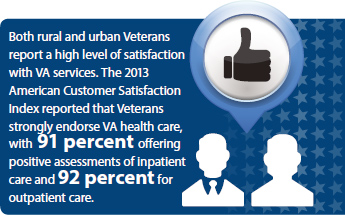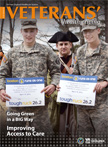Veterans' Healthy Living, Summer 2014
Improving Access to Care
VA is the largest integrated health care system in the United States, caring for approximately 5.3 million Veterans in primary care settings. One way VA is successfully meeting the needs of that many Veterans is with Patient Aligned Care Teams (PACTs).
Since its inception in 2010, the PACT program has transformed the way Veterans receive their primary care. PACTs make health care more patient friendly—more personalized and more accessible to patients—and this has improved Veteran satisfaction.
With PACT, Veterans are treated using a coordinated team approach focused on wellness and disease prevention. Each Veteran's team consists of a primary health care provider, a Registered Nurse care manager, a clinical associate, and an administrative associate. Pharmacists, social workers, nutritionists, and behavioral health staff support PACTs.
"We've always had primary care providers working closely with patients," said Eric Shirley, the Primary Care Service Line Director for VISN 1. "However, PACT is more patient-centered because the teams are now starting to create a personalized health plan for each Veteran. Continuity of care is also improved—the same team every time. Patients also havebetter access to care because we can use the phone or secure messaging in MyHealtheVet or Telehealth to look after them."
 Dr. Shirley explains that part of PACT is shared decision-making with the patient. "Instead of just finding and fixing diseases or illnesses, we ask Veterans what they want their health for, and what we can do to help them achieve better health. Each Veteran is part of his or her team. I prefer a small team environment because if a patient needs help from a nurse, I go to the team nurse. If a patient needs to reschedule, I go to the team administrative associate. Based on a Veteran's team, I know who to go to for help."
Dr. Shirley explains that part of PACT is shared decision-making with the patient. "Instead of just finding and fixing diseases or illnesses, we ask Veterans what they want their health for, and what we can do to help them achieve better health. Each Veteran is part of his or her team. I prefer a small team environment because if a patient needs help from a nurse, I go to the team nurse. If a patient needs to reschedule, I go to the team administrative associate. Based on a Veteran's team, I know who to go to for help."
Veterans share that advantage— knowing who to go to—because the same team is handling every aspect of their primary care every time. Based on surveys, patients are satisfied with the results of the PACT, and hospital admissions are down throughout the VA. Part of improving access to care includes VA Medical Centers offering extended hours. "Many patients like coming in early in the morning, or on Saturdays," Shirley says. "Parking isn't usually a problem, they get in quickly, and they get on with their day. It's much more convenient."
Another tool for improving access to care is the use of Telehealth, which has increased dramatically in recent years. Communicating with health care professionals through secure electronic means is especially helpful for Veterans in rural locations, as are the community-based outpatient clinics (CBOCs) in VISN 1.
RBPS | Going Green | Improving Access | Homeless Veterans | Outreach Efforts

















